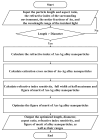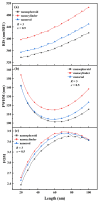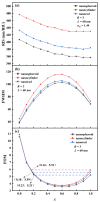Analysis and Optimization of Rotationally Symmetric Au-Ag Alloy Nanoparticles for Refractive Index Sensing Properties Using T-Matrix Method
- PMID: 40648759
- PMCID: PMC12251251
- DOI: 10.3390/nano15131052
Analysis and Optimization of Rotationally Symmetric Au-Ag Alloy Nanoparticles for Refractive Index Sensing Properties Using T-Matrix Method
Abstract
Previous investigations devoted to non-spherical nanoparticles for biosensing have primarily addressed two hot topics, namely, finding nanoparticles with the best shape for refractive index sensing properties and the optimization of size parameters. In this study, based on these hot topics, Au-Ag alloy nanoparticles with excellent optical properties were selected as the research object. Targeting rotationally symmetric Au-Ag alloy nanoparticles for biosensing applications, the complex media function correction model and T-matrix approach were used to systematically analyze the variation patterns of extinction properties, refractive index sensitivity, full width at half maximum, and figure of merit of three rotationally symmetric Au-Ag alloy nanoparticles with respect to the size of the particles and the Au molar fraction. In addition, we optimized the figure of merit to obtain the best size parameters and Au molar fractions for the three rotationally symmetric Au-Ag alloy nanoparticles. Finally, the range of dimensional parameters corresponding to a figure of merit greater than 98% of its maximum value was calculated. The results show that the optimized Au-Ag alloy nanorods exhibit a refractive index sensitivity of 395.2 nm/RIU, a figure of merit of 7.16, and a wide range of size parameters. Therefore, the optimized Au-Ag alloy nanorods can be used as high-performance biosensors. Furthermore, this study provides theoretical guidance for the application and preparation of rotationally symmetric Au-Ag alloy nanoparticles in biosensing.
Keywords: Au-Ag alloy nanoparticles; T-matrix method; biosensing; figure of merit; optimization.
Conflict of interest statement
The authors declare no conflicts of interest.
Figures









Similar articles
-
Signs and symptoms to determine if a patient presenting in primary care or hospital outpatient settings has COVID-19.Cochrane Database Syst Rev. 2022 May 20;5(5):CD013665. doi: 10.1002/14651858.CD013665.pub3. Cochrane Database Syst Rev. 2022. PMID: 35593186 Free PMC article.
-
The effect of sample site and collection procedure on identification of SARS-CoV-2 infection.Cochrane Database Syst Rev. 2024 Dec 16;12(12):CD014780. doi: 10.1002/14651858.CD014780. Cochrane Database Syst Rev. 2024. PMID: 39679851 Free PMC article.
-
Cost-effectiveness of using prognostic information to select women with breast cancer for adjuvant systemic therapy.Health Technol Assess. 2006 Sep;10(34):iii-iv, ix-xi, 1-204. doi: 10.3310/hta10340. Health Technol Assess. 2006. PMID: 16959170
-
Clinical symptoms, signs and tests for identification of impending and current water-loss dehydration in older people.Cochrane Database Syst Rev. 2015 Apr 30;2015(4):CD009647. doi: 10.1002/14651858.CD009647.pub2. Cochrane Database Syst Rev. 2015. PMID: 25924806 Free PMC article.
-
Behavioral interventions to reduce risk for sexual transmission of HIV among men who have sex with men.Cochrane Database Syst Rev. 2008 Jul 16;(3):CD001230. doi: 10.1002/14651858.CD001230.pub2. Cochrane Database Syst Rev. 2008. PMID: 18646068
References
-
- Mulvaney P. Surface Plasmon Spectroscopy of Nanosized Metal Particles. Langmuir. 1996;12:788–800. doi: 10.1021/la9502711. - DOI
-
- Sajid F., Diego R., Zafar S., Renato E.d.A. Ultra-sensitive narrow-band plasmonic perfect absorber for sensing applications. Photonics Nanostructures-Fundam. Appl. 2022;50:101018.
-
- Prince J., Arvind K.S., Janmejay K.P., Sahil G., Shonak B., Mayan K.A., Sanjeev K., Neha S., Neena G., Arun K.S. Ultra-thin metamaterial perfect absorbers for single-/dual-/multi-band microwave applications, IET Microw. Antennas Propag. 2020;14:390–396.
Grants and funding
LinkOut - more resources
Full Text Sources

